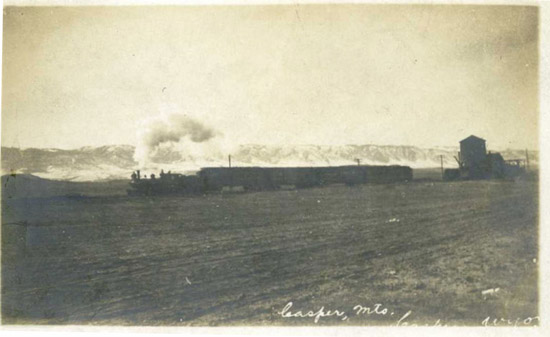
Chicago and Northwestern train, approx., 1910.
Oil production and railroads had a symbiotic relationship. Oil production without a means of transporting it to the
market has little value. The coming of the railroads to Casper combined with proximity to the Salt Creek fields produced the oil boom in Casper.
 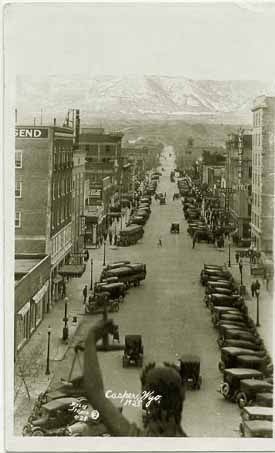
Left, Oil Exchange Building, approx 1917;
Right, Center Street, 1925
The Oil Exhange Building, now known as the Consolidate Royalty Building, was constructed in 1917 and
was designed by Garbutt and Weidner. On the left in the right hand photo is the Hotel Townsend, still a landmark
in Casper. On the right is the Gladstone Hotel, now gone.
Other important buildings related to the oil industry included the
art deco Ohio Oil Company Building (now Marathon Oil).
By 1906, the Chicago and Northwestern, formerly the Fremont, Elkhorn & Missouri Valley, connected Casper westward to Lander, Shoshoni, and Riverton in the Wind River Basin.
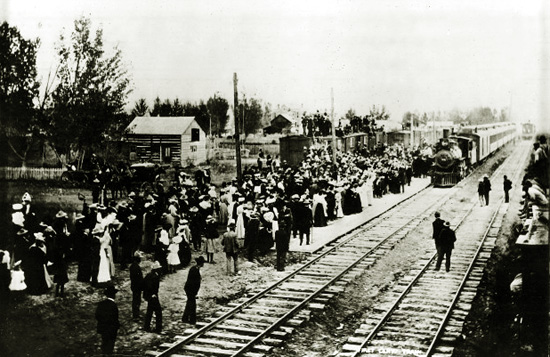
First Chicago and Northwestern Train from the west, 1906.
In 1943, the Lander Extension was abandoned and the last train from the west arrived in late that year.
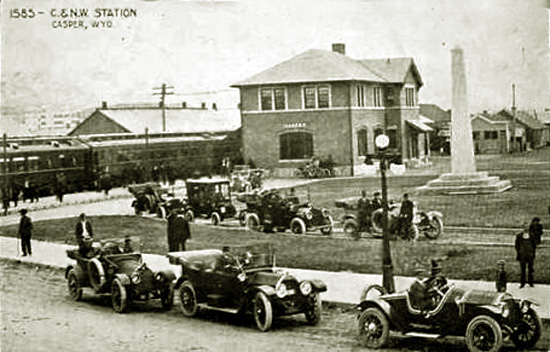
Chicago and Northwestern passenger station, approx. 1916.
Note the steering wheels on the cars. Americans did not switch to left-hand drive until the
19-teens. The roundabout and the monument were added in 1911 and dedicated to the early pioneers who passed through the area on the
Oregon Trail. The inscription on the southside of the monument read:
ERECTED ON THE SITE
OF THE
OLD OREGON TRAIL
IN MEMORY OF THE PIONEERS WHO
BLAZED THE WAY
BY THE PIONEERS OF THE PRESENT
DAY
NATRONA COUNTY PIONEER
ASSOCIATION
1849. . . . . . . . . .1911
The Pioneer Association raised $1,500 for the cost of the Indiana limestone of which the pillar is
constructed. The Chicago and Northwestern contributed the monumennt base, labor, land, and transportation of the
limestone.
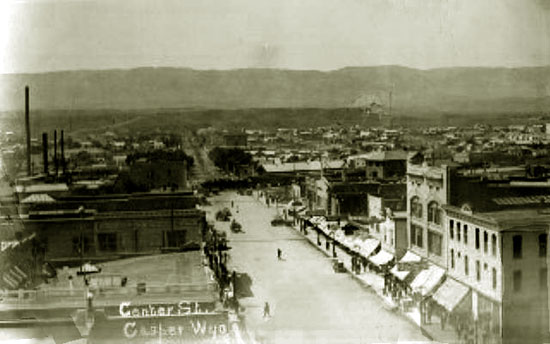
Center Street looking south.
The terminal is visible just to the right of the center of the photograph, over the roofs,
to the right of where Center Street is blocked by a stopped train.
The depot was on the west side of Center Street where Rails to Trails presently crosses the street. On the right-hand side of the
photo is the three story Grand Central Hotel with its porches removed. Next to it is a taller
three story building which housed the Wyoming Saloon. Separated from it by an alley is a shorter
two story building which appears to be the Caledonian Bar and pool room operated by D. A. "Dan"
Robertson. Robertson, born in Canada, came to Casper about 1890 from Miles City. Dan was active in Democratic Party politics and
served in the 1903 Legislature. Later he had to take the "hit" for Casper having lost out on the distribution
of the state goodies to various towns in the state. The Democrats blamed the Republicans for having defeated Casper's bid for the
State Normal School because Dan Robertson proposed it:
POOR CASPER
The State Capitol was traded
for the Industrial Convention;
the State Fair was stolen from us without a whimper; the State
Normal School was lost because
Dan Robertson proposed it; the
ranchers, cowpunchers, sheenmen
and sheeD herder's trade has been lost to Casner by reason
of the fact that in all the precincts
west of Casper open gambling
has been allowed. Casper
has been injured by being a
closed town, and other places being allowed to remain open.
Close all or none. Give us a
square deal.
Voters, are you going to vote
for a "good fellow" who has
never done anything, to your own
ruin. When your own personal
interests are at stake? Why
have "good fellowship" rob you
of your bread and butter? A vote for the Democratic ticket
from Alex. Webel down means a
vote for Casper. Casper Press, October 9, 1908, p. 1
Robertson for a while owned
a race horse named "Doc Middleton" which had won numerous races in Nebraska. Robertson purchased
the horse with the intent that it
be a ringer in an upcoming race. Robertson claimed that the horse was only a fancy caqrriage horse.
Dan practiced the horse numberous time. The competitor learning of Dan's scheme and purchased his own
race horse. Dan's horse was named after famed Nebraska horse thief and
endurance rider Doc Middleton. See
Douglas.
Robertson's bar apparently did very well. In September, 1907, the
saloon was robbed of $2100.00 by Dallas and E. C. Irwin. The Irwins were caught several weeks later in
Laramie City. Before construction and opening of the Odd Fellows Hall, the Masonic Lodge met upstairs over
Dan's Saloon.
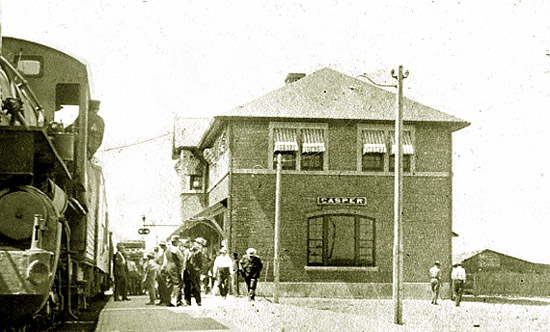
Eastbound train Chicago and Northwestern passenger station, approx. 1910.
In the meantime, the Chicago, Burlington & Quincy was busy extending its lines westward to connect with Billings, Montana. On October 20, 1913, the Chicago, Burlington and Qunicy reached Casper.
The two railroads made Casper the center for shipping in central Wyoming. Shippers could send Cattle, wool, and oil by rail in all directions.
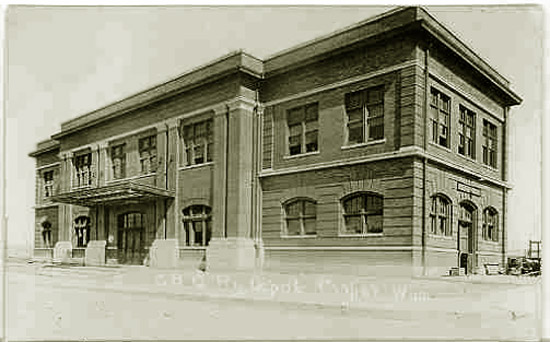
Chicago, Burlington and Quincy passenger station.
The station is located at the northern end of Wolcott Street. As of 2012, it is still in use as office space for the
Burlington Northern and Sante Fe.
Next page: Casper continued.
|